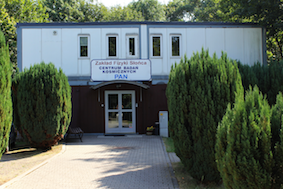Welcome to our Division web pages
Address:
Space Research Centre
Polish Academy of Sciences
Solar Physics Division
ul. Kopernika 11, 51-622 Wrocław
tel: (+48) 71 3483 238 fax: (+48) 71 3729 372
Space Research Centre
Polish Academy of Sciences
Solar Physics Division
ul. Kopernika 11, 51-622 Wrocław
tel: (+48) 71 3483 238 fax: (+48) 71 3729 372

The Solar Physics Department (SPD) in Wrocław is part of the Space Research Center of the Polish Academy of Sciences, located in Warsaw. Our work studies the physics of the Sun, stars, and the Earth's magnetosphere. We specialize in analyzing and interpreting spectra and X-ray images of the Sun.
The main research areas of SPD include:
For over 50 years, the Solar Physics Department has also specialized in the design and construction of space instruments, which are crucial for solar research. Our devices have been onboard many prestigious space missions, enabling detailed analysis of X-ray radiation and energetic particles emitted by our star. Our instruments contribute to a better understanding of solar activity, including flares and coronal mass ejections, which directly influence space weather.
Key rocket experiments and orbital missions in which the Solar Physics Department actively participated include:
Data analysis, publications, and grants
A key element of the Solar Physics Division is the analysis of scientific data collected from space missions. To this end, advanced data interpretation techniques and computer models are employed, enabling the study of phenomena occurring on the Sun and a better understanding of the interactions between the Sun and the Earth. SPD scientists play a significant role in the scientific community, regularly publishing their research findings in reputable international journals such as The Astrophysical Journal, Solar Physics, Astronomy & Astrophysics , and The Monthly Notices of the Royal Astronomical Society. These publications have brought significant recognition to the department, with numerous citations in the scientific world. Additionally, SPD projects are supported by various research grants, both national and international. Our division has successfully secured funding from institutions such as the National Science Center (NCN) in Poland, the European Space Agency (ESA), and the Horizon 2020 program of the European Union. These funds enable SPD to continue pioneering scientific research and develop new space instruments.
- Diagnosing energy release processes and physical conditions in the plasma of solar flares.
- Hydrodynamic modelling of solar flares to better understand their mechanisms.
- Determining the chemical composition of plasma in solar corona structures.
- Forecasting proton flares, which are significant for predicting space weather.
For over 50 years, the Solar Physics Department has also specialized in the design and construction of space instruments, which are crucial for solar research. Our devices have been onboard many prestigious space missions, enabling detailed analysis of X-ray radiation and energetic particles emitted by our star. Our instruments contribute to a better understanding of solar activity, including flares and coronal mass ejections, which directly influence space weather.
Key rocket experiments and orbital missions in which the Solar Physics Department actively participated include:
- 1970: Rocket Mission Vertical-1 – The rocket reached an altitude of 487 km. The objective of the experiment was to measure the X-ray spectrum of the Sun and to investigate the density of electrons and ions, as well as the temperature of electrons in the upper atmosphere.
- 1971: Rocket Mission Vertical-2 – An altitude of 463 km was achieved. This mission largely repeated the objectives of Vertical-1.
- 1977: Rocket Mission Vertical-5 – The rocket reached an altitude of 500 km, with the scientific goal being the diagnostics of the Sun's X-ray spectrum.
- 1979 and 1981: Rocket Missions Vertical-8 and Vertical-9 – The launches took place on September 29, 1979, and August 28, 1981, respectively. The rockets reached altitudes of 505 km and 500 km. Both missions were international projects in which Poland provided instruments for observing the Sun's X-ray spectrum.
- 1983: Suborbital Mission Vertical-11 – The launch occurred on October 20, 1983, with the rocket reaching an altitude of 500 km. Solar radiation measurements were conducted, and Poland supplied diagnostic equipment for X-ray analysis.
- 1995: INTERBALL-Tail Mission – SPD participated in the development and construction of the X-ray photometer RF15-I, which measured the Sun's X-ray radiation in the energy range of 2 to 240 keV.
- 2001: Orbital Mission CORONAS-F – SPD designed and constructed two X-ray spectrometers: RESIK (for observing the Sun's X-ray radiation in the range of 3.3 – 6.1 Å) and DIOGENESS (for observing the triplets of the Ca XIX, S XV, and Si XIII lines).
- 2009: Orbital Mission CORONAS-PHOTON – SPD developed the X-ray photometer SPHINX, which became part of an international collaboration among scientists from Ukraine and Poland.
- 2020: Interplanetary Mission Solar Orbiter – SPD participated in the development of equipment for ground tests for the STIX instrument, which observes the Sun's X-ray spectra in the range of 4 to 150 keV
Data analysis, publications, and grants
A key element of the Solar Physics Division is the analysis of scientific data collected from space missions. To this end, advanced data interpretation techniques and computer models are employed, enabling the study of phenomena occurring on the Sun and a better understanding of the interactions between the Sun and the Earth. SPD scientists play a significant role in the scientific community, regularly publishing their research findings in reputable international journals such as The Astrophysical Journal, Solar Physics, Astronomy & Astrophysics , and The Monthly Notices of the Royal Astronomical Society. These publications have brought significant recognition to the department, with numerous citations in the scientific world. Additionally, SPD projects are supported by various research grants, both national and international. Our division has successfully secured funding from institutions such as the National Science Center (NCN) in Poland, the European Space Agency (ESA), and the Horizon 2020 program of the European Union. These funds enable SPD to continue pioneering scientific research and develop new space instruments.
Space Research Centre PAS, Solar Physics Division 51-622 Wrocław, Kopernika 11


